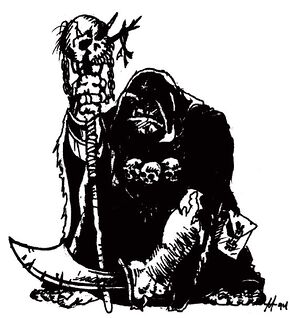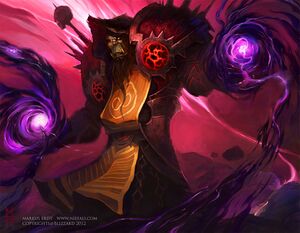Necrolyte

Necrolytes are a type of necromancer who use the dark energies of the Void,[1] as it was discovered by Natalie Seline. As such, they sometimes overlap with warlocks and shadow priests in their depiction.
Origins
The first necrolyte to walk the world of Azeroth, Sataiel, was given the scythe known as Ulthalesh, the Deadwind Harvester, by the titan Sargeras himself.[2] Sataiel is also sometimes just described as the first necrolyte in other sources.[3]
With Kil'jaeden's help, Gul'dan has formed a group of orcs called necrolytes. They dedicated themselves to learning the dark arts of necromancy. Through it, they would be able to spread plagues to the draenei and raised the dead to fight at the Horde's side.[4][5]
First War

- Main article: Necrolyte (Warcraft I)
During the First War, the main purpose of the necrolytes was to bolster the orcish forces with undead troops, similar to the necromancers of the Scourge decades later. While necrolytes did possess other magical abilities, they were quite paltry when compared to those of the other orcish warlocks. Their spells included Shadow Spear, Raise Dead, Dark Vision, and Unholy Armor.
Second War
Unfortunately for the necrolytes, the rise of Orgrim Doomhammer was a precursor to their downfall. Doomhammer slaughtered the majority of the necrolytes while Gul'dan was in a psychic coma. Once Gul'dan awoke, he begged Doomhammer to spare his life, promising him to create a host of spellcasting undead riders capable of combating the human mages. The remaining necrolytes, led by Rakmar Sharpfang,[6] proved themselves incapable of imbuing corpses with consciousness, which frustrated Gul'dan. He did nevertheless see potential in them, but not while they were among the living. Gul'dan and Cho'gall ritually sacrificed almost all of them.[7][8]
Gul'dan and Cho'gall went on to create the death knights. Each newly-risen death knight was given a jeweled truncheon through which it could better focus its powers. Into these jewels were infused the raw, necromantic powers of the freshly slain necrolytes.[9]
Third War
Orcish necrolytes were not gone for good, as some remained within the Stormreaver clan, surviving their ordeals on the Broken Isles. An unknown warlock coven in Durotar, who Stormreaver necrolytes were a part of, stole an ancient artifact from Morg Wolfsong and his fellow shamans but was eventually destroyed by Rexxar.
World of Warcraft
The Scourge employ many necrolytes but also necrolords, who could be advanced forms of necrolytes. In the alternate Draenor the Shadowmoon clan is also depicted as having several masters of the necromantic arts, including necrolytes, a reference to their original description as "practitioners of the Orcish religions".[10]
Affliction warlocks are also shown as having abilities like ![]() [Secrets of the Necrolyte] while also being able to use
[Secrets of the Necrolyte] while also being able to use ![]() [Ulthalesh, the Deadwind Harvester].
[Ulthalesh, the Deadwind Harvester].
Notable necrolytes
Types
- Scholomance Necrolyte - Scholomance
- Bleeding Hollow Necrolyte - Hellfire Peninsula

- Orc Necrolyte - Karazhan

- Cultist Necrolyte - Borean Tundra

- Burning Depths Necrolyte - Dragonblight

- Deathwhisper Necrolyte - Pit of Saron

- Kor'kron Necrolyte - Icecrown Citadel

- Death's Head Necrolyte - Razorfen Downs

- Shadowmoon Necrolyte - Shadowmoon Valley

Warcraft I
Necrolytes first appeared as a unit of the Orcs in Warcraft: Orcs & Humans. They were described as such:
Necrolytes are practitioners of the Orcish religions. These binders of souls command the black powers that hold control over the earth. Linked into the dominions of the lower plains, Necrolytes have power over all things dark and evil, including the raising of fallen warriors to create armies of the undead. Through ceremonies performed at their Temples, they learn to warp the essence of shadow to use for their advantage.[10]
Speculation
This article or section includes speculation, observations or opinions possibly supported by lore or by Blizzard officials. It should not be taken as representing official lore.
|
There are sometimes references to a necrolyte clan, though it may be a euphemism for a more formally named clan, such as the Shadowmoon clan, or perhaps merely referring to the necrolyte class as a group, not unique to any clan.
Gallery
Necrolyte in Hearthstone.
Vrykul Necrolyte in Hearthstone.
See also
References
- ^ World of Warcraft: The Magazine Issue 4
- ^ Tome of Blighted Implements
- ^
 [Grimoire of the First Necrolyte]
[Grimoire of the First Necrolyte]
- ^ World of Warcraft: Chronicle Volume 2, pg. 78
- ^ Warcraft II: Tides of Darkness manual, The History of Orcish Ascension, The Rise of the Shadow Council
- ^ Tides of Darkness, chapter 6
- ^ Warcraft II: Tides of Darkness manual, The History of Orcish Ascension, The First War of Orcish Ascension
- ^ World of Warcraft: Chronicle Volume 2, pg. 145
- ^ Warcraft II: Tides of Darkness manual, Ground Units of the Orcish Horde, Death Knight
- ^ a b Warcraft: Orcs & Humans manual, Orcish Horde of the First War, Necrolyte
es:Necrólito



